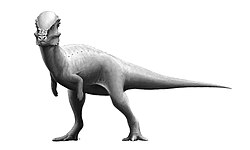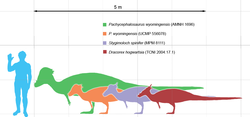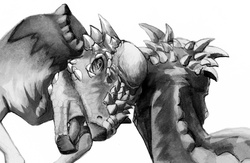Stygimoloch
Stygimoloch is a dubious genus of herbivorous dinosaur. It is known from fossil remains dating to the late Cretaceous period, about 70 million to 66 million years ago.
| Stygimoloch | |
|---|---|

| |
| Reconstructed skull at the Museum für Naturkunde, Berlin | |
| Scientific classification | |
| Kingdom: | Animalia |
| Phylum: | Chordata |
| Order: | Ornithischia |
| Family: | Pachycephalosauridae |
| Genus: | Stygimoloch Galton & Sues, 1983 |
| Species: | S. spinifer
|
| Binomial name | |
| Stygimoloch spinifer Galton & Sues, 1983
| |
| Synonyms | |
| |
Like other pachycephalosaurids, Stygimoloch was a bipedal herbivore with short forelimbs and a thick, domed skull, likely used in intraspecific head-butting. The skull of Stygimoloch is notable for the elongated spikes that surround the dome.
22% of all domes examined had lesions suggesting osteomyelitis, a bone infection resulting from trauma, suggesting the animals engaged in intraspecific combat, akin to extant bighorn sheep.[1]
Stygimoloch fossils were first discovered in North America, in Montana and Wisconsin. The first was discovered in Hell Creek, Montana and was named in 1983 by Peter M. Galton, a British paleontologist and Hans-Dieter Sues, a German paleontologist.
Young Pachycephalosaurus
Today, many scientists believe that Stygimoloch and the smaller Dracorex represent immature specimens of Pachycephalosaurus rather than distinct genera. This theory was first put forth by paleontologist Jack Horner in 2009. It has been supported by studies involving the animals' skulls.[2] Dracorex and Stygimoloch both display higher amounts of porus bone than Pachycephalosaurus, indicative of immature individuals.[3]
Stygimoloch Media
Several pachycephalosaur relatives discovered from Hell Creek
Casts of three skulls, representing possible growth stages, Museum of the Rockies
References
- ↑ Peterson, JE; Dischler, C; Longrich, NR (2013). "Distributions of cranial pathologies provide evidence for head-butting in dome-headed dinosaurs (Pachycephalosauridae)". PLOS ONE. 8 (7): e68620. Bibcode:2013PLoSO...868620P. doi:10.1371/journal.pone.0068620. PMC 3712952. PMID 23874691.
- ↑ Horner, John R.; Goodwin, Mark B. (2009-10-27). "Extreme Cranial Ontogeny in the Upper Cretaceous Dinosaur Pachycephalosaurus". PLOS ONE. 4 (10): e7626. doi:10.1371/journal.pone.0007626. ISSN 1932-6203. PMC 2762616. PMID 19859556.
- ↑ "Three dino types may be just three dino ages". 2009-10-27. Retrieved 2025-07-04.









